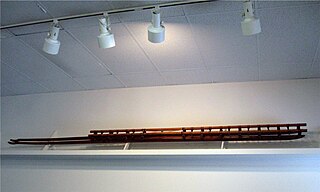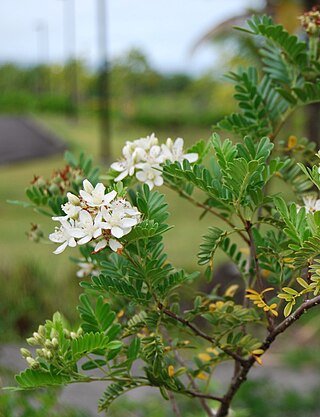In the Hawaiian religion, Wākea, the Sky father weds Papahānaumoku, the earth mother. The two are considered the parent couple of the ruling chiefs of Hawaii.

The flag of Hawaii was first adopted in the early 19th century by the Hawaiian Kingdom and continued to be used after its overthrow in 1893. It is the only U.S. state flag to feature a foreign country's national flag—that of the UK's Union Jack—which commemorates the British Royal Navy's historical relations with the Kingdom of Hawaii, and in particular the pro-British sentiment of its first ruler, King Kamehameha I.

Native Hawaiians are the Indigenous Polynesian people of the Hawaiian Islands.

Kapa is a fabric made by native Hawaiians from the bast fibres of certain species of trees and shrubs in the orders Rosales and Malvales. The bark is beaten and felted to achieve a soft texture and dye stamped in geometric patterns.

Hawaiian lava sledding is a traditional sport of the Native Hawaiians. Similar to wave surfing, heʻe hōlua involves the use of a narrow wooden sled. The sled is used standing up, lying down, or kneeling, to ride down man-made or naturally occurring courses of rock, often reaching speeds of 50 mph (80 km/h) or greater. In the past, Hawaiian lava sledding was considered both a sport and a religious ritual for honoring the gods.

The Hawaiian archipelago consists of 137 islands in the Pacific Ocean that are far from any other land. Polynesians arrived there one to two thousand years ago, and in 1778 Captain James Cook and his crew became the first Europeans to visit Hawaii. The art created in these islands may be divided into art existing prior to Cook’s arrival; art produced by recently arrived westerners; and art produced by Hawaiians incorporating western materials and ideas. Public collections of Hawaiian art may be found at the Honolulu Museum of Art, the Bishop Museum (Honolulu), the Hawaii State Art Museum and the University of Göttingen in Germany.
Richard Kekuni Akana Blaisdell, was professor emeritus of medicine at the University of Hawaiʻi at Mānoa in Honolulu, and a longtime organizer in the Hawaiian Sovereignty Movement.

Osteomeles anthyllidifolia, commonly called ʻŪlei, eluehe, uʻulei, Hawaiian rose, or Hawaiian hawthorn, is a species of flowering shrub in the rose family, Rosaceae, that is indigenous to Hawaiʻi, the Cook Islands, Tonga, Pitcairn Island, and Rapa Iti, Taiwan and the Ryukyu islands of Japan.

William Tufts Brigham (1841–1926) was an American geologist, botanist, ethnologist and the first director of the Bernice P. Bishop Museum in Honolulu.
Preston Singletary is a Native American glass artist.

Kapulani Landgraf is a Kanaka Maoli artist who is best known for her work in black-and-white photography. Through a series of photographic essays, objects, and installations, Landgraf celebrates Native Hawaiian culture while also addressing the legacies of colonialism and its impact on indigenous Hawaiian rights, value and history. While her work often centers on the negative impacts of land use and development, she also alludes to the resilience of the land and the indigenous population. Landgraf says about her work, "Although much of my work laments the violations on the Hawaiian people, land and natural resources, it also offers hope with allusions to the strength and resilience of Hawaiian land and its people.” Landgraf's most recent work combines photographic series with objects and installations.
Debora Moore is a contemporary glass artist. She is best known for her glass orchids.
Noelani Goodyear-Kaʻōpua is a Kanaka Maoli scholar and educator whose work centers on Native Hawaiian social movements, culture-based education, and energy and food politics.
Tʼuyʼtʼtanat-Cease Wyss is a Skwxwú7mesh (Squamish), Stó꞉lō, Kānaka Maoli (Hawaiian), Irish-Métis, and Swiss multi-media artist, ethnobotanist, independent curator, educator, activist, and small business owner based in Vancouver, British Columbia. Tʼuyʼtʼtanat is Wyss's ancestral name, which means “woman who travels by canoe to gather medicines for all people.” Wyss's interdisciplinary practice encompasses aspects of visual art, fiber arts, ethnobotany, storytelling, and community education, among other interdisciplinary approaches, and she has been working with new media, performance, and interdisciplinary arts for more than 30 years. As a Coast Salish weaver, Wyss works with wool and cedar and uses indigenous plants in the dyeing process. Wyss also engages with beekeeping and gardening practices as part of community-led initiatives and as a way to explore aspects of land remediation - the ability of plants to remediate soil that has been contaminated with colonial toxins.
Dalani Tanahy is an American artist specializing in the Hawaiian art of creating kapa, fabric made by beating bark. Tanahy creates kapa for artistic and ceremonial purposes and teaches courses and workshops. She is the founder of Kapa Hawaii, an organization dedicated to reviving and preserving the art of kapa creation.

Greta Mae "Puanani" Kanemura Van Dorpe (1933–2014) was an American artist and master of kapa, the Hawaiian art of making cloth from bark fibers. Van Dorpe spent more than forty years researching the forgotten craft of making kapa, investigating the tools and materials used by ancient Hawaiians and experimenting to replicate the cloth. She has been credited as one of the women responsible for reviving the art of kapa in the 1970s.
Mary "Aunty Malia" Blanchard Solomon was an American textile artist and expert on Hawaiian customs, crafts, and culture. Solomon researched and traveled across the South Pacific to regain lost knowledge about kapa, the traditional Hawaiian craft of making cloth from the fibers of trees. The Chicago Tribune called Solomon one of Hawaii's "foremost amateur anthropologist/historians."
Maile Tomlinson Meyer-Broderick is a Kānaka Maoli community advocate, entrepreneur, small-business owner, nonprofit executive director, publisher, and consultant.

Solomon Enos is a Native Hawaiian artist, illustrator, and activist. Enos has had their work displayed at the National Museum of the American Indian and Bernice Pauahi Bishop Museum.

Roen Halley Kahalewai McDonald Hufford is a Native Hawaiian Kapa artist who was named as one of nine National Heritage Fellows by the National Endowment for the Arts (NEA) in 2023. Her work has been displayed in the Bishop Museum and the Hawaii State Art Museum.










